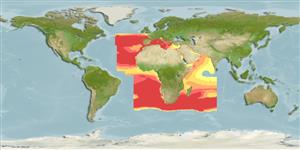Teleostei (teleosts) >
Myctophiformes (Lanternfishes) >
Myctophidae (Lanternfishes) > Diaphinae
Etymology: Diaphus: Greek, dis, dia = through + Greek, physa, phyo = to beget, to have as offspring (Ref. 45335).
Eponymy: Ernest William Lyons Holt (1864–1922) was a British marine naturalist, ichthyologist and soldier who served in the Nile Campaign (1884–1885) and the Third Burmese War (1886– 1887) during which he was invalided home. [...] (Ref. 128868), visit book page.
Environment: milieu / climate zone / depth range / distribution range
Ecology
Marine; bathypelagic; oceanodromous (Ref. 51243); depth range 40 - 777 m (Ref. 56504). Deep-water; 50°N -
Eastern Atlantic: Bay of Biscay including the Mediterranean to Liberia (uncommon between Morocco to Mauritania). Elsewhere in the Atlantic Ocean, south and east of 50°N and 45°W to 35°N, but east of 35°W to about 20°N. Indian Ocean: two specimens at 29°30'S, 64°56'E.
Length at first maturity / Size / Weight / Age
Maturity: Lm ?, range 5 - ? cm
Max length : 7.0 cm SL male/unsexed; (Ref. 4479); max. published weight: 5.80 g (Ref. 126117)
High-oceanic, found between 225-650 m during the day and between 40-275 m at night exhibiting size stratification with depth and with adult females below 450 m (Ref. 4479). Depth range from 300-777 m in the eastern Ionian Sea (Ref. 56504). Large juveniles, sub-adults and adults from the Mediterranean are known to be migratory (Ref. 4775).
Life cycle and mating behavior
Maturity | Reproduction | Spawning | Eggs | Fecundity | Larvae
Hulley, P.A., 1990. Myctophidae. p. 398-467. In J.C. Quero, J.C. Hureau, C. Karrer, A. Post and L. Saldanha (eds.) Check-list of the fishes of the eastern tropical Atlantic (CLOFETA). JNICT, Lisbon; SEI; Paris; and UNESCO, Paris. Vol. 1. (Ref. 4479)
IUCN Red List Status (Ref. 130435: Version 2024-2)
Threat to humans
Harmless
Human uses
Tools
Can't connect to MySQL database fbquizv2. Errorcode: Too many connections
